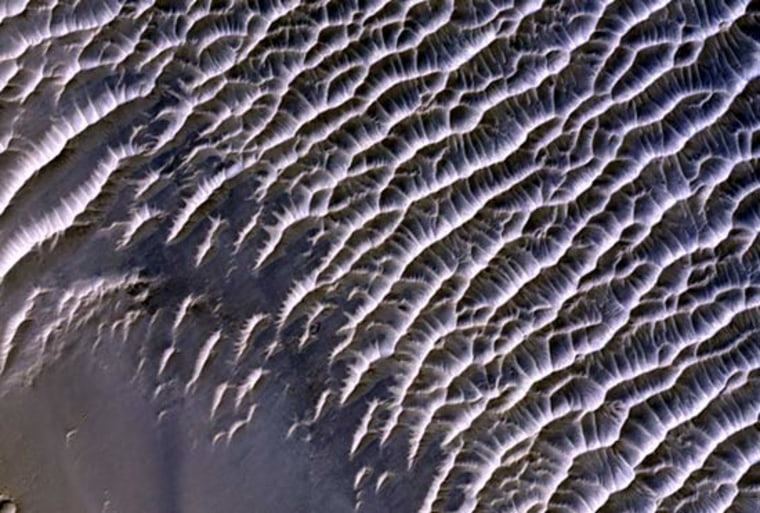The nature of strange ripples of sand on the Martian surface is clearer now thanks to pole-to-pole images returned by a NASA spacecraft. But even with this new information, scientists still are unsure just how the features, which are unlike anything on Earth, came to be.
The ripples are found over large swaths of Mars. They are smaller than the red planet's gigantic dunes but larger than sand ripple fields found on Earth.
Called Transverse Aeolian Ridges (TARs), these unusual features are formed by wind-driven particles (phenomena involving air movement are known as "Aeolian processes"). The winds blow the ridges into many shapes: simple ripples, forked ripples, snake-like sinuous waves, crescent shapes and complex, over-lapping networks.
Scientists study TARs because they hold clues to the past and present climate processes on Mars, and because they can trip up NASA's rovers currently rolling around the Martian surface, as has already happened to the Mars Exploration Rover Opportunity.
Matt Balme of the Planetary Science Institute in Tucson, Ariz., and his colleagues conducted a comprehensive pole-to-pole survey of more than 10,000 images of TARs taken by the Mars Orbiter Camera, part of the Mars Global Surveyor spacecraft (which launched in 1996 and orbited Mars at least until 2006 when it stopped responding to signals), to gain more insight into the strange features.
The images showed that the TARS:
- Are more common in the southern hemisphere of mars than in the northern hemisphere.
- Are found in an equatorial belt between 30 degrees north latitude and 30 degrees south latitude.
- Exist in two distinct environments: near layered terrain or adjacent to Large Dark Dunes (LLDs).
- Are abundant in the Meridiani Planum (a plain 2 degrees south of Mars' equator) region and in southern-latitude craters.
Additional information on TARs came from Opportunity's 2005 encounter with one of the ridges. The rover was bogged down for six weeks with its wheels firmly stuck in the sand.
Opportunity's time stuck in the ridge showed that at least this TAR was composed of an outer layer of granule-sized material ranging from about 0.08 inches (2 millimeters) to 0.2 inches (5 millimeters). Below that outer layer was a mixed mass of fine and coarse particles.
How they form
TARs need two things to form, Balme explained: a supply of sediment and strong winds. The sediment requirement helps explain why the features are found near dunes and layered terrain, he added.
Both dunes and layered terrain (which could have been formed by ancient sand dunes, ocean or lake deposits, or layers of volcanic ash) provide the raw material for the TARs.
Steep slopes can also provide additional particles for ripple formation as they erode. This factor could explain why TARs are confined to a central belt around the planet, Balme said, because steep slopes are not generally found in the middle to far north and south latitudes of Mars.
TARs also come in two age ranges: Those near layered terrain are generally several million years old and inactive, while the ones near LLDs are young and may still be actively forming and moving.
"My theory is that the very young TARs are found near the Large Dark Dunes, which are also very young, because the sand blowing off the dunes provides the energy needed to form TARs," Balme said. "Meanwhile you have areas near layered landforms that used to have active sediment transport, but no longer [do]. This shows a dynamic environment that has changed, and we might be able to use TARs as paleo-markers to help decipher ancient climates."
Current models that examine circulation patterns in Mars' atmosphere don't provide much evidence that wind patterns and atmospheric densities on Mars were significantly different in the past than from what they are now.
"But I think the geology we are seeing suggests that there might have been different patterns and densities," Balme said. "The observations we're getting now from Mars Global Surveyor [data analysis] and the HiRISE camera (flying aboard the Mars Reconnaissance Orbiter [currently orbiting Mars]) are giving us really good data to drive the models."
In addition to figuring out what processes formed the TARs, scientists also still don't know exactly what materials compose the various TAR fields or why they see these large features on Mars, but not on Earth.
"Over the next couple of years we should be seeing many more images from HiRISE that can gives us more information, for example, about the heights versus spacing and whether TARs have more in common with dunes or the ripple fields found on Earth," Balme said.
HiRISE images of the fields taken over long time intervals could show small movements within some of the TAR fields, indicating which ones are still active and possibly demonstrating how they form, Balme said.
